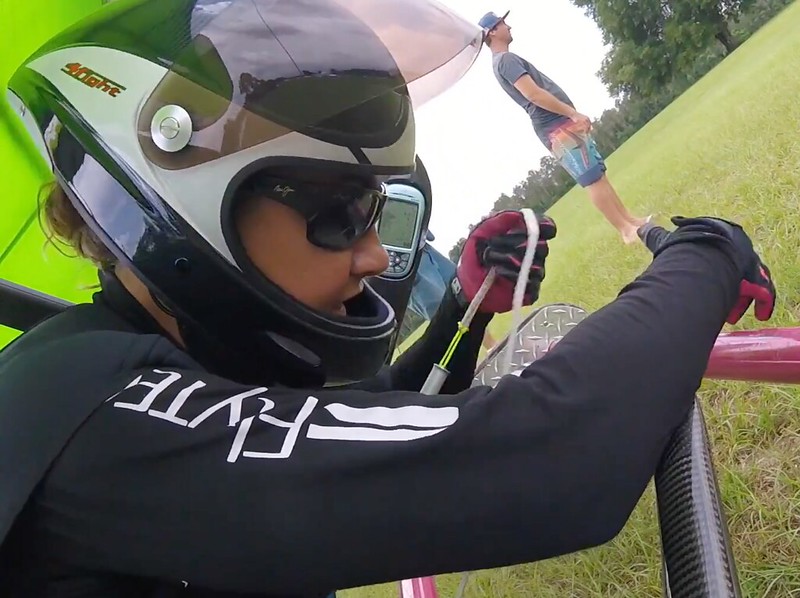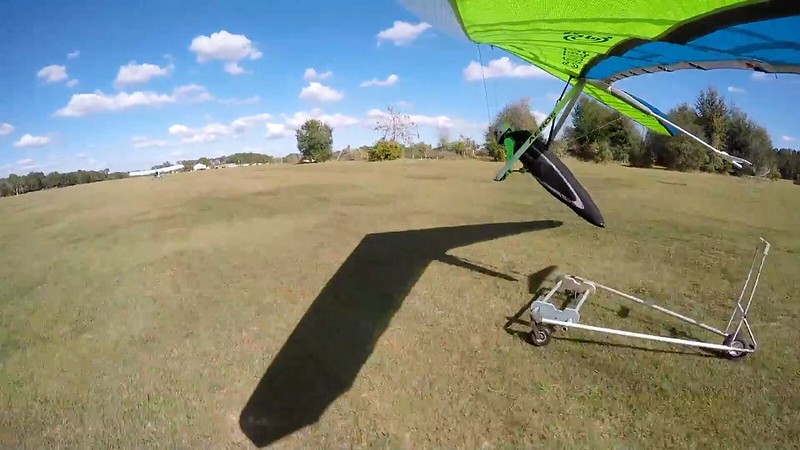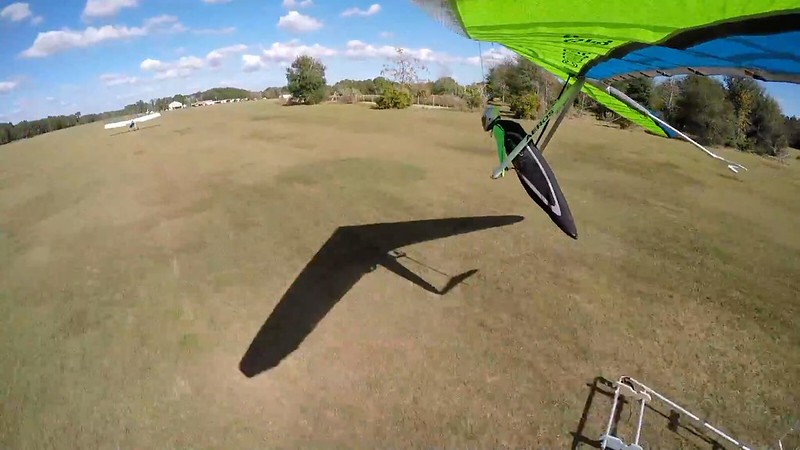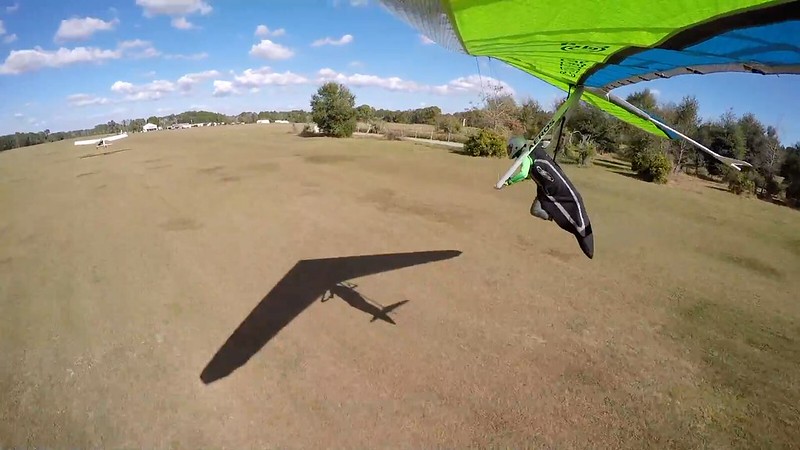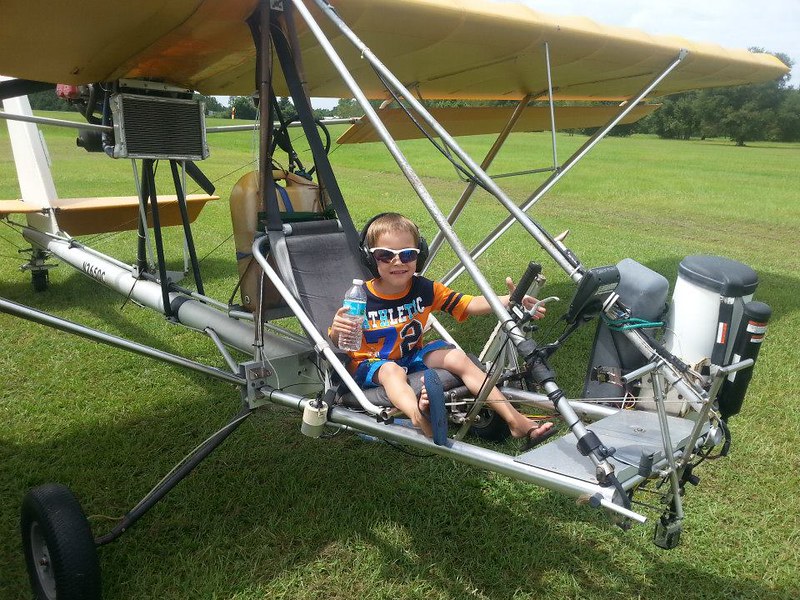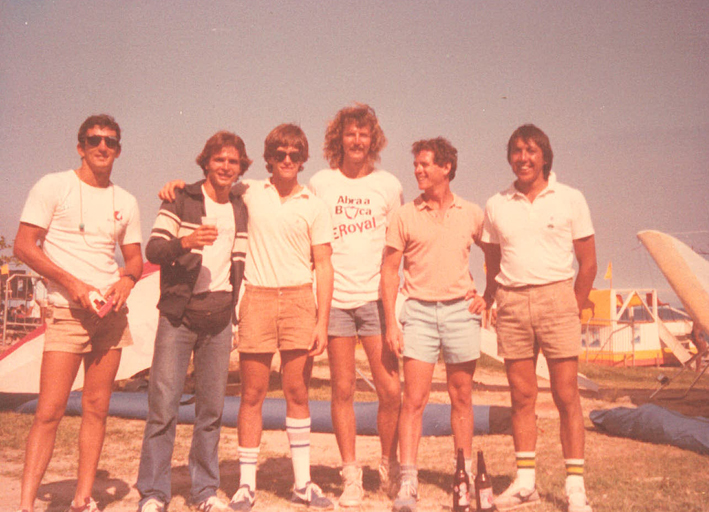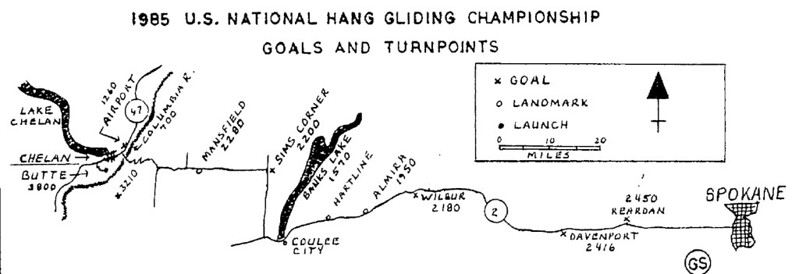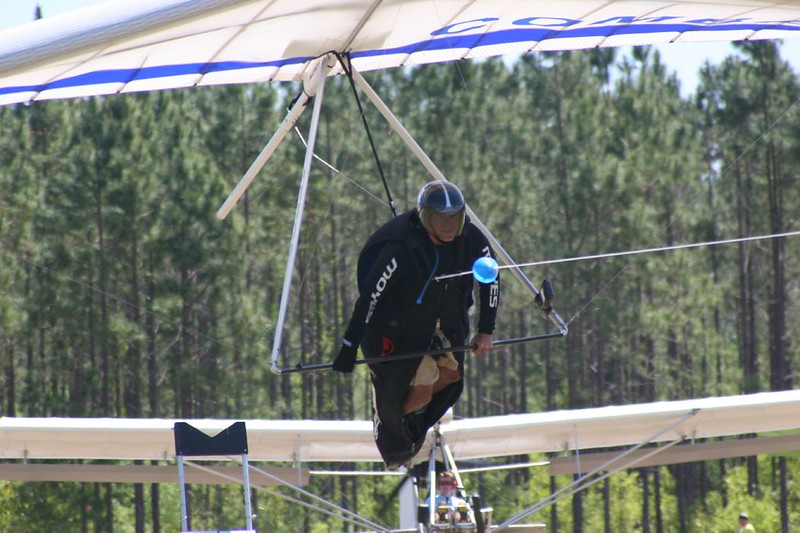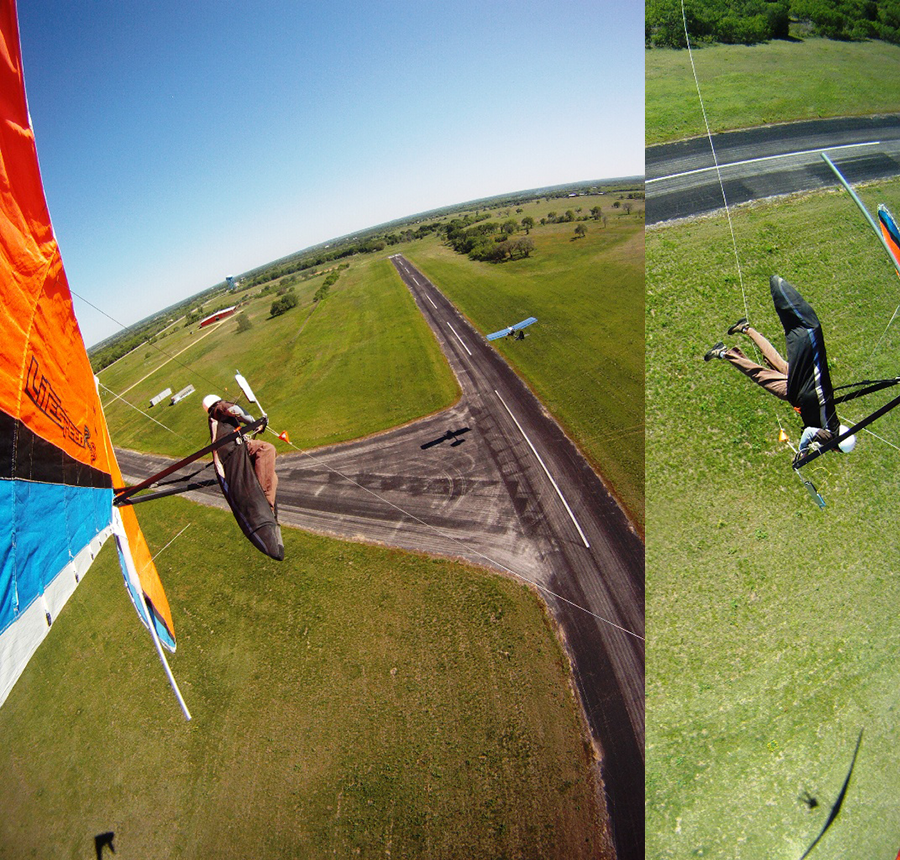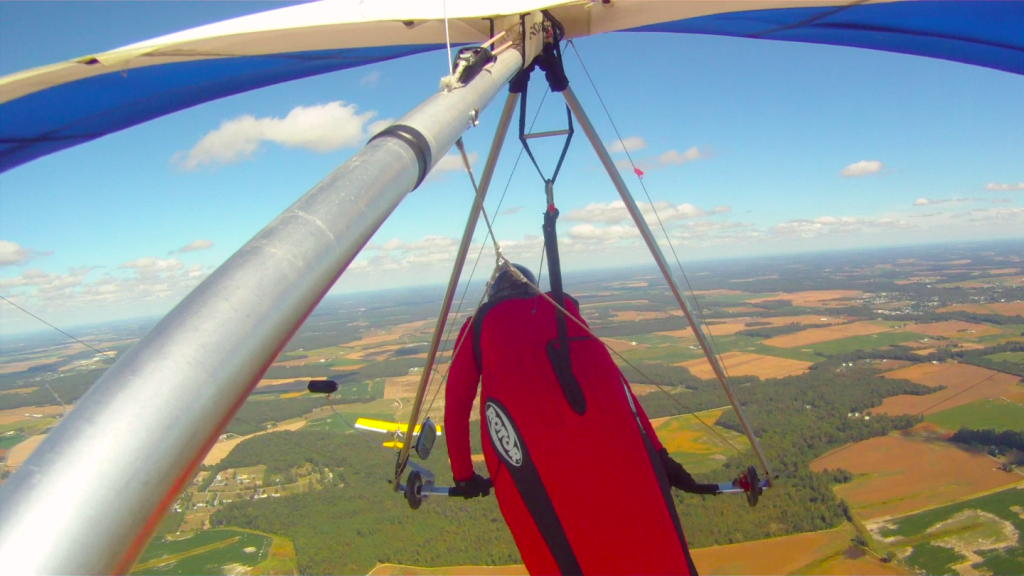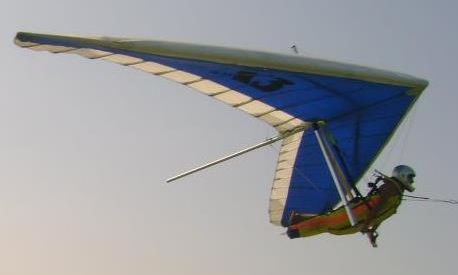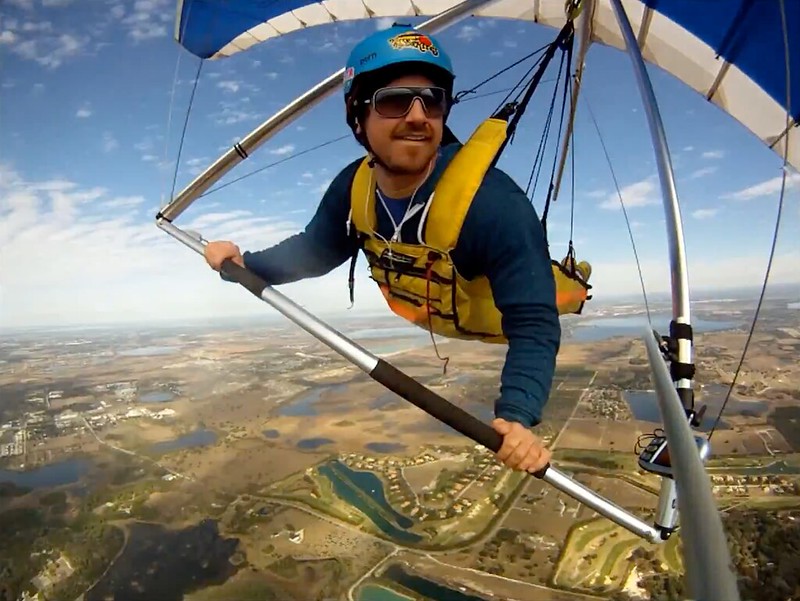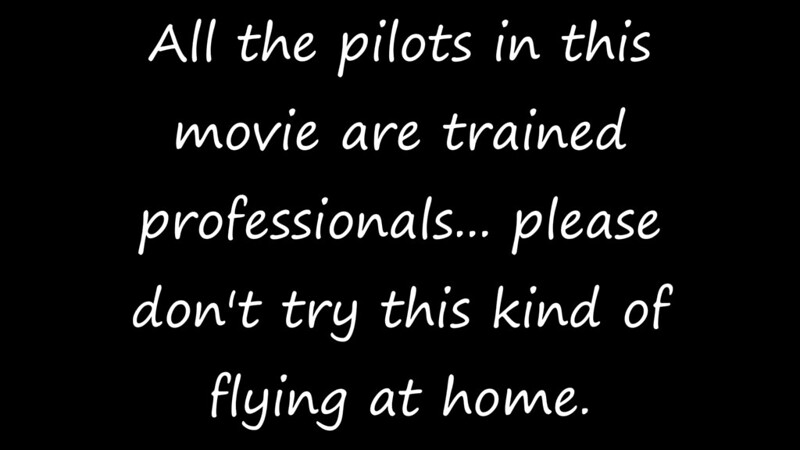This one needs a serious review...
Rob Kells - 1985/09
Accident Report
Chris Bulger
On July 17 you and I lost one of the most gifted pilots who has ever been in the sport of hang gliding. Chris Bulger started flying at age thirteen, and had racked up thousands of hours in hang gliders, hundreds in trikes and many in airplanes. The guy was a pilot's pilot: one of the world's best, and as the saying goes, he could have flown a picnic table.
The following is a brief summary of what happened during the tow flight that cost Chris his life. It is presented here with the hope that all who aero tow will not repeat the mistakes that were made; we know that Chris would want it that way.
I was not at the airport that day so what follows are my conclusions after talking with many of the people who were there and personally inspecting the equipment that was being used, after the accident.
It was late in the afternoon, and the conditions were smooth. A number of successful tows had been made that day without mishap. Kenny Brown, Mitch McAleer, and Jeff Huey each had clean tows to approximately 2500'. While Chris was towing John Pendry they climbed to between 1,000 and 1,500 feet.
Chris made a fairly sharp right turn which caused John to lock out to the left. John was fighting to get back behind the tow vehicle. At one point he started to recover from the lock out and then felt a "bump" (hard pull on the line). The trike tumbled, the single strands of 505 leech line that went from John's shoulder straps to the three-ring broke one at a time, and presumably the shackle pulled out of the trike release at the same time the second strand of 505 gave way.
The trike tumbled a second time, and broke a leading edge, and then on the third tumble Chris was thrown out and fell approximately 500' to his death. Exactly what happened will never be known but studying the physical evidence suggests several observations:
THE WEAK LINK:
It was one continuous strand of 205 leech line looped through the ring on the three-ring circus release (glider pilot end) and the tow rope, and fastened together with a fisherman's knot. This material is rated at 125 lbs. per strand by the manufacturer. The strength of the weak link would figure to be 4 X 125 = 500 lbs. minus the loss in strength due to friction and the knot. I have done several load tests with this material and duplicate hardware and found that the "weak link" was good for at least 400 lbs. Chris was telling me at breakfast that morning that Thevenot, when towing at the factory, doesn't use a weak link. In any case the weak link that was being used did not break. It is recommended that you never use a weak link good for more than 150 to 200 lbs. I have been using for years a single loop of 205 with three overhand knots and two bowlines to tie the ends together. Its breaking strength is between 210 and 215 lbs. It has always broken when necessary, but sometimes a little more time was required than I was comfortable with.
If you're towing, USE A WEAK LINK and test its breaking strength on numerous samples. Be sure it is breaking consistently at UNDER 200 lbs.
THE TRIKE RELEASE:
The trike was manufactured in Australia by Ricky Duncan. The trike release had been tested by the manufacturer for a straight pull of 300 lbs. They had always used 150-lb. weak links and had never had a release failure. Due to the increased load with this weak link it appears that the release on the trike did malfunction. It was a steel pin on the end of a cable that went through two bolts with a shackle fitting in between. The cable was routed to a foot peddle at the nose of the trike. The trike inspection revealed that the pin was bent above the bottom bolt making release from the trike end impossible, and the cable was broken away from the foot pedal, indicating that Chris was trying hard to pin John but was unable to. So a release that was tested to 300 lbs. proved inadequate for a 350-lb. plus load at an angle up and to the side. It is of course also possible that the release was damaged on the ground by an impulse load caused by the rope snagging on something.
THE GLIDER
The glider was a Moyes GTR 180 which had been modified to increase wing area and airframe strength for the purpose of using with a trike. This particular glider had undergone continuing modifications as late as the day of the accident. There is no evidence that the glider was a contributing factor in the incident, but at the same time there is no data on file which establishes its level of airworthiness.
PILOT RELEASE:
It is my understanding that John did not have a lot of aero tow experience. He was locked out and putting everything he had into recovering. It's tough to let go when you're locked out and it has usually been the case that the better the pilot the more attempt is made to recover rather than release well before a lock out becomes severe, especially when on high tow.
THE PILOT RESTRAINT SYSTEM:
The pilot restraint in the trike was a single lap belt of two-inch webbing with a pinch type buckle, so when open you can actually take the buckle right off. I think the buckle would be OK if it were clamped down fully but it seems too easy to misuse this system. I believe in four-point harnesses in all ultralights. It is all too easy to deploy a chute or tumble and then be thrown out of a lap belt. The appearance of the trike suggests that Chris may have survived had he stayed in the trike.
NO PARACHUTE:
Chris had no parachute. They had one in the trailer, but they were too anxious to get towing to take the time to put it on. In view of the fact that Chris came out of the trike it would not have helped him unless it was the type that attached a pilot harness to the chute and the trike.
NO HELMET:
Chris wasn't wearing a helmet. It may not have mattered in this case, but it could have. A pilot cannot do much to help himself if he is knocked out in the air.
Hang glider towing has been around since the earliest days of foot launched hang gliding itself. It has long been felt by many that towing has the potential to open up hang gliding to a much wider potential market of pilots. The major stumbling block through the years has been safety; towing has always been more dangerous, both inherently and statistically, than foot launched flying. Recent advances involving improved winches, the center-of-mass bridle system and the use of relatively weak "weak links" have offered new promise of increased safety in towing. The development of aero towing has made towing feasible from smaller fields, once more promising to extend the range of potential flying sites.
However, Chris Bulger's accident should serve to remind us that the dangers involved in towing are still very significant. There are few pilots in the world, if any, more skilled than John Pendry. Chris Bulger was both a highly skilled hang glider pilot and a very experienced trike pilot. They were towing in mellow, ideal conditions. They made a few seemingly innocuous mistakes, and it cost Chris his life.
NEVER underestimate the danger in towing, and never shortcut or ignore any safety procedures. Let's not let Chris Bulger's tragic death be for nothing.
On July 17 you and I lost one of the most gifted pilots who has ever been in the sport of hang gliding.
Sounds like those gifts didn't serve him all that well in the long run. Thinkin' maybe being gifted ain't all it's cracked up to be in this sport.
Chris Bulger started flying at age thirteen...
Did he get Bob's permission first?
...and had racked up thousands of hours in hang gliders, hundreds in trikes and many in airplanes. The guy was a pilot's pilot: one of the world's best, and as the saying goes, he could have flown a picnic table.
- Just not a purpose designed and built trike tug in front of solo glider being flown by a former world champion hang glider pilot in mellow, ideal conditions.
- Bullshit, Rob. You can fly your brains out on these things and there's just so good you can get. We don't have much in the way of control authority in hang gliders and it's real tough to tell people apart once a solid competence level has been reached. Being able to make the right calls in XC thermal flying... That's more complex and dependent on depth of knowledge and experience but has zilch bearing on any of the issues here.
- There's a lot more to being a PILOT than the dumb jock stuff that's all you've told us about. To be an actual PILOT you need to understand aeronautical theory and the integrity of the equipment you're using to commit aviation. I'm not seeing any evidence that Chris was significantly registering on those other category scales.
The following is a brief summary...
- Why? This one wasn't important enough for a full detailed accounting?
- Where can those of us who are interested in something better than a brief summary go to find it?
...of what happened during the tow flight that cost Chris his life.
It wasn't the tow flight that cost him his life. It's what he was and wasn't using for it and did just before the end of it.
It is presented here with the hope that all who aero tow will not repeat the mistakes that were made...
Great presentation, Rob. It's been close to a third of a century since this one and there's never been anything close to like it anywhere on the planet. And just think how much better we could've done with a fully detailed report.
...we know that Chris would want it that way.
- Should Chris be getting a vote?
- What about his family? I thought we weren't supposed to discuss any of these out of respect for the victim's family.
I was not at the airport...
Undoubtedly Lake Chelan Airport - S10 - but please don't burden us with details like that.
...that day so what follows...
Is pure speculation. If you weren't there you can't really understand any of the shit that went south.
...are my conclusions after talking with many of the people who were there...
So he talked with MANY - but not ALL - of the people who were there. So we know that there were a lot of witnesses to this one. (I personally knew at least one of the crowd present from my opposite edge of the continent and my earliest days of flying hang gliders. Juan Sonen relayed to me that he was seeing iffy crap on that one but that it was too hard to call these world class rockstars on it.) And how very odd that we never got any personal accounts and perspectives from any of them on this major traumatic horror show. The only report we get is from an Industry operative who wasn't even on site at any time on crash day and...
... and personally inspecting the equipment that was being used, after the accident.
...only inspected the equipment after it had been swept up and removed from the scene of the crime.
So...
- Had anyone cared to personally inspect any of the equipment that was being used BEFORE the "accident"? Just kidding.
- Bummer no one thought to take and publish any photographs of the equipment that was being used - after and/or before the accident. But this is just a brief summary of what happened during the tow flight that cost Chris his life - so we wouldn't have seen them here anyway.
- How 'bout inspections of the equipment that WASN'T being used? Aside from the Tad-O-Link it sounds like you're OK with everything.
It was late in the afternoon, and the conditions were smooth.
Meaning they WEREN'T smooth EARLY in the afternoon.
A number of successful tows had been made that day without mishap.
- What number, Rob? It's plural so we know at least two were made that day without mishap.
- Don't we get to hear about the number of unsuccessful tows that had been made that day WITH mishap? There fuckin' obviously WERE some or you wouldn't be writing with this subtle misleading crap style.
- Oh. So everybody was towing in compliance with the AT regs published and distributed in the magazine two and half weeks prior to this fatal...
USHGA Aerotow Guidelines
from the USHGA Safety and Training Committee
The FAA has granted the USHGA an exemption that allows aerotowing of hang gliders according to these guidelines. Aerotowing is a new and different way of flying hang gliders and must be done according to these guidelines for safety and legality.
II AEROTOWING EQUIPMENT
3) A weak link must be placed between the tow line and the release at both ends of the tow line with the forward link ten percent stronger than the rearward weak link. The weak link must have a breaking strength less than 85% the weight of the hang glider and pilot combination, not to exceed 200 pounds.
...nobody had a weak link heavier than 0.85 Gs / 200 pounds - whichever was less - and there were no "mishaps" - just maybe a seventy percent safety inconvenience rate, with the usual resulting complement of broken downtubes.
Kenny Brown, Mitch McAleer, and Jeff Huey each had clean tows to approximately 2500'.
Hear that, people of varying ages?. Kenny Brown, Mitch McAleer, and Jeff Huey each had clean tows to approximately 2500 feet. And that's noteworthy. Three named individuals, at least two of them rockstars, who made it all the way up to obviously designated release altitude - likely in the late afternoon glass air. Point of pride.
And the tows were "clean"? Do we talk about the "dirty" tows that we had during a day at Ridgely?
The tows were CLEAN because they were in the late afternoon glass-off. They were breaking weak links left and right during the soaring window.
While Chris was towing John Pendry they climbed to between 1,000 and 1,500 feet.
And the former world champion hadn't made any tows prior to that one? I notice you don't say anything about John Pendry having had a previous clean tow to approximately 2500 feet.
Chris made a fairly sharp right turn which caused John to lock out to the left.
Oh really. For no reason whatsoever - in late afternoon glass air - Chris made a "fairly" sharp right turn which caused John to lock out to the left.
Bull fucking shit. The only sane reason Chris would've had to make "a fairly sharp right turn" in no wind - notice there's zero mention of wind - sled conditions would've been to stay in safer range of the runway. Also notice there's not the slightest effort to offer any possible motivation for this incident critical action.
John was fighting to get back behind the tow vehicle.
- Yeah? Why was he unable to track smoothly behind the tug in glass air no matter what it did? How many of us have trouble immediately rolling to match tug bank angles and stay in position in the most brutal of thermal conditions? Was the problem that he was flying one point with the bar fully stuffed behind a tug with a high stall speed and couldn't handle anything beyond the most gradual of turns?
- Right. The "tow vehicle". We really talk like that. It would be unthinkable to say the tug, the trike, Chris. This is being written with FAA ears in mind. Sure, we can do this safely. The problem was just that the "weak link" they used was good for at least 400 pounds - over twice the strength of what is recommended - and did not break (before something else did). And studious avoidance of any reference to all of the SOPs that were flagrantly violated.
- Wow. Somebody should've clued John in as to the definition of a LOCKOUT. Then he wouldn't have been wasting so much time and effort and endangering Chris fighting to get back behind the tow vehicle.
- And apparently Chris - started flying at age thirteen, had racked up thousands of hours in hang gliders, hundreds in trikes, many in airplanes, a pilot's pilot, one of the world's best, could've flown a picnic table - didn't know what a lockout was either. Otherwise he'd have blown him off immediately upon recognizing that John wasn't gonna.
At one point he started to recover from the lock out...
Yep. That's a former world champion fer ya. The difficult we do right away, the impossible just takes us a little longer.
Total bullshit misleading regarding the severity of Chris's turn and the resulting misalignment.
...and then felt a "bump" (hard pull on the line).
So what was he WATCHING at this point? He is using his superb pilot skills to recover from the "lockout", is coming back into position, has no intention of releasing, and FEELS a "bump"? Hey people of varying ages... Show of hands from those of us who've ever felt a "bump" on the line that wasn't related to turbulence and/or some slack line situation.
The trike tumbled...
- So it wasn't a BUMP, it was a SURGE.
- Yeah. With God's Gift to Aviation at the wheel, John Pendry recovering from the lockout induced by Chris's fairly sharp turn, the two planes level with each other, the engine running fine, the trike just TUMBLES. Doesn't even bother to nose up into a mild stall first.
- Glaringly conspicuous and deliberate absence of any account of what the tug was doing between making the fairly sharp right turn which caused John to lock out to the left and the tumble. And we've got John watching from a couple hundred feet away and undoubtedly a couple dozen pairs of eyes pointed up from takeoff. Classic sleight of hand maneuver. Get the audience's attention focused on the decoy, palm and pocket the real deal with the other hand.
...the single strands of 505 leech line that went from John's shoulder straps to the three-ring broke one at a time...
- Why? How come they're blowing now and didn't during the "bump"?
- In other words, an effective 252.5 towline pound weak link. The single strands are tied so cut the rating in half. And we know from this very clear account of them breaking "one at a time" that they weren't sharing the load AT ALL. 'Cause if they had been there'd have been a virtually instantaneous double plus shock load applied to the surviving strand and the bridle halves failures would've been perceived as simultaneous.
...and presumably the shackle pulled out of the trike release at the same time the second strand of 505 gave way.
Great engineering. Under a 250 pound load the trike's release actuation system turns to scrap metal.
The trike tumbled a second time, and broke a leading edge, and then on the third tumble Chris was thrown out and fell approximately 500' to his death.
- Pity he wasn't able to find a picnic table on the way down.
- Wow, people of varying ages! Looky what a detailed and precise description of the sequence of events we have in the first several seconds of things having gone irretrievable south! Now compare/contrast with the description we have of what was going in in the three seconds before. We don't have shit regarding lateral angle off center, relative altitudes, glider bar position. (Nice job, Rob.)
Exactly what happened will never be known...
Yeah, if you guys couldn't do it there it couldn't be done. 'Specially after everyone had all their film confiscated and exposed to direct sunlight before being returned. (Right, Jon Orders?)
So does that sound just a wee bit familiar...
http://ozreport.com/forum/viewtopic.php?t=30971
Zach Marzec
William Olive - 2013/02/27 20:55:06 UTC
Like the rest of us, you have no idea what really happened on that tow.
We probably never will know.
Jim Rooney - 2013/02/28 01:17:55 UTC
Well said Billo
I'm a bit sick of all the armchair experts telling me how my friend died.
...to anyone? (Also a tumble fatality by the way. The more spectacular the incident the harder it is to determine what really happened.)
...but studying the physical evidence suggests several observations:
THE WEAK LINK:
- Yeah, the weak link. Focal point of a safe towing system. Wasn't a recommended relatively weak one and thus didn't break when it was supposed to. Primary issue in this one so naturally needs to be the first thing discussed. How 'bout we make it:
THE WEAK LINK
to make sure everybody reading this report really understands the only issue that really matters.
- What the fuck do you mean "THE" weak link, Rob? This was an aerotow and there was a legal - not to mention COMMON SENSE - requirement for weak links on BOTH ends of the towline. And the one up front is required to be ten percent heavier than the one in back. And that's a pretty SPECIFIC SOP. And nowhere in this report do we hear a single syllable about what it was if there was one or its absence if there wasn't. No wait, I forgot. This is just a brief summary of what happened during the tow flight that cost Chris his life. Forget I mentioned it.
- The back end weak link was John's bridle half. Everything else at that end was irrelevant. And for the purpose of this incident everything else related to tension limitation was irrelevant.
It was one continuous strand of 205 leech line looped through the ring on the three-ring circus release (glider pilot end) and the tow rope...
Note that on a three-ring circus release the third ring...
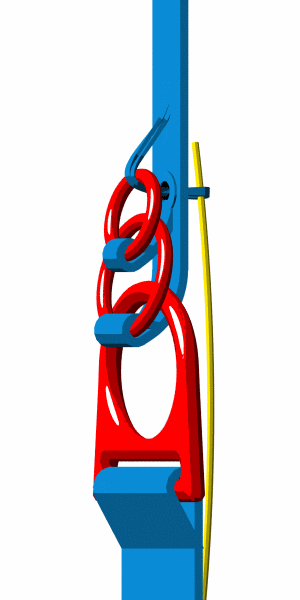
..isn't really part of the release. It's on the end of whatever's being released - the skydiver in its original application, towline in this case. So the third ring is serving as the tow ring and the double loop of 205 is installed between the towline and tow ring.
...and fastened together with a fisherman's knot. This material is rated at 125 lbs. per strand by the manufacturer.
This material is rated at 205 pounds by the manufacturer. That's why they call it 205 leechline.
The strength of the weak link would figure to be 4 X 125 = 500 lbs. minus the loss in strength due to friction and the knot.
- How did we get four? This is a DOUBLE loop but you only described a single.
- Friction? Bullshit. A weak link has a weak link. And unless it's substantially frayed - in which case all bets are off and it shouldn't be used anyway - that weak link is always gonna be at the point of a knot. And for that dividing by two is a safe enough bet.
- This weak link is gonna be 4x205/2=405 - MAX. And that's pretty much identical to what Davis and many of us suddenly became happy with immediately after the 2013/02/02 Zack Marzec inconvenience tumble fatality at Quest.
I have done several load tests with this material and duplicate hardware and found that the "weak link" was good for at least 400 lbs.
Oh. You've done several tests with a duplicate configuration and all you can tell us is that the "weak link" - which wasn't the weak link anyway 'cause the limitation was either bridle half - was good for AT LEAST 400 pounds. What was it good for AT MOST - asshole? Eight hundred? Did you bother to test it to failure? You said you did SEVERAL tests. So did you just go up to four hundred, back off, repeat several times?
Look at the pattern here:
Dennis Pagen - 1997/01
1996/07/25 - Bill Bennett / Mike Del Signore
The weak link was at the top end was tested after the accident to break at over 300 pounds (it was constructed from 205 Dacron line). Because of this doubling effect of the bridle, this would require a towline force of over 600 pounds to break.
http://ozreport.com/9.032
The Worlds - weaklinks
Rohan Holtkamp - 2005/02/07
2005/01/09 - Robin Strid
His actual weaklink did test to be stronger than 180kg... (176 and 396 pounds)
These assholes don't tell us what weak links in historic global interest fatals DO break at. They just tell us what they DON'T break at. So for the purposes of the exercises these weak links could've been aircraft carrier anchor chain links.
Chris was telling me at breakfast that morning that Thevenot, when towing at the factory, doesn't use a weak link.
- Then Thevenot's a total fucking asshole. A weak link sure as hell isn't the focal point of a safe towing system but a weak link appropriate for its purpose sure as hell IS the cornerstone around which a safe towing system is engineered.
- Got that, people of varying ages?
http://ozreport.com/forum/viewtopic.php?t=24846
Is this a joke ?
Jim Rooney - 2011/08/31 09:25:57 UTC
See, you don't get to hook up to my plane with whatever you please. Not only am I on the other end of that rope... and you have zero say in my safety margins... I have no desire what so ever to have a pilot smashing himself into the earth on my watch. So yeah, if you show up with some non-standard gear, I won't be towing you. Love it or leave it. I don't care.
The inventor of the world's first practical hang glider aerotow tug would rather not use ANYTHING in the way of a weak link behind him. And it shouldn't matter anyway...
Dr. Trisa Tilletti - 2012/06
You and I have flown sailplanes for almost as long as we have flown hang gliders. We own two sailplanes and have two airplanes that we use for towing full-size sailplanes. In all the time that we have flown and towed sailplanes, we have not experienced or even seen a sailplane weak link break.
Just like in sailplanes.
In any case the weak link that was being used did not break.
- Just like the one(s) in your several tests, right Rob?
- The weak link that was being used was the bridle half. It broke. That was the only figure that mattered. So how come you didn't bench test that component to failure and report? 'Cause it would've only made it to 250 pounds and that would work to undermine all this Industry Infallible Weak Link / focal point of a safe towing system bullshit? Another glaringly conspicuous deliberate omission of critical relevant information.
It is recommended that you never use a weak link good for more than 150 to 200 lbs.
- Oh great! They don't even hafta know anything about what we weigh to recommend what we should never use! These guys are GOOD!
- By whom? Why? Based on what experimental and/or field data? So is that what you meant when you wrote:
Rob Kells - 2005/02
Aerotow Release Attachment Points for Wills Wing Gliders
Always use an appropriate weak link with a finished length of 1.5 inches or less.
regarding aerotowing your glider models? That doesn't even get us up close to the 130 pound Greenspot Standard Aerotow Weak Link that you put on your demo gliders at all the flight parks. And I don't see where you revised those figures even in 2004 when the FAA hang glider aerotow regulations made that range illegally light for just about everything we fly.
Also, people of varying ages... Note that while Rob / Wills Wing was only too happy to put on paper in undeletable black and white actual numbers on recommended appropriate weak link strength right after this 1985/07/17 Chris Bulger but a bit under two decades later not a shadow of a ghost of any actual numbers in the magazine article which has been made instantly globally accessible on their website. If it looks like shit, walks like shit, quacks like shit, smells like shit...
- Is that what it says in the SOPs? And if not, why should what is recommended be different from the just prior published SOPs?
- So is that how things work in sailplaning? Some anonymous dickhead just pulls some numbers out of his ass and recommends what we should never use minus the slightest pretense of a justification or explanation?
- You just told us that Chris was the greatest thing to happen to hang gliding since sliced bread. What are the qualifications of the anonymous assholes presenting figures radically different from what Chris judged appropriate? He got killed so that automatically invalidates all of his perspectives on towing?
- Who the fuck are you to select authorities whose recommendations we're supposed to accept? Wills Wing gliders have been designed for foot launched soaring flight and not to be motorized, tethered, or towed. And how many people did you assholes mangle before coming up with a solution to keep your gliders' nose wires from detaching in the process of a platform tow launch? Doesn't telling us what weak links we shouldn't be using intrude on that purity, start falling into the realm of towing design?
I have been using for years a single loop of 205 with three overhand knots and two bowlines to tie the ends together.
- Oh. Two Bowlines. Everybody and his fuckin' dog use the one Fisherman's Knot like what you reported for this incident. It's THE knot for the application. But you use two Bowlines to join the ends. One uses a Bowline for an application in which one wants to be able to untie after loading. That's its advantage. Its DISadvantage is that it can untie itself if it's not continuously loaded. But that would just be an inconvenience at worst in hang glider towing.
- Did you ever test it to see if the Overhand Knots made the slightest difference?
- THREE Overhand Knots. Good thinkin', Rob...
-- That way if your primary Overhand Knot doesn't work...
http://www.chgpa.org/forums/viewtopic.php?f=2&t=1079
$15 pacifiers
Jim Rooney - 2005/09/20 13:11:43 UTC
Sorry, I don't see the logic in trying to save a couple bucks on equipment that I am litterally entrusting my life to. "Pacifier"? may be... but there's an old saying out there... "You never need the backup, until you need the backup".
I know of at least one pilot out there that flies with two caribiners. His logic makes more sense to me... you can't have too many backups.
...you have two backups going for ya.
-- Each knot makes the weak link thirty pounds safer. Three knots, ninety pound better lockout protection. Or maybe...
http://www.hanggliding.org/viewtopic.php?t=27393
Pro towing: 1 barrel release + weak link or 2 barrel release
Juan Saa - 2012/10/18 01:19:49 UTC
Boca Raton
The normal braking force in pounds for a weak link is around 180, at least that is the regular weak link line used at most aerotow operations. By adding a second weak link to your bridal you are cutting the load on each link by half, meaning that the weak link will not break at the intended 180 pounds but it will need about 360.
If that is what you use and is what your instructor approved then I have no business on interfering, i dont know if you are using the same weak link material but there shoul be only ONE weak link on a tow bridle for it to be effective in breaking before higher loads are put into you and the glider should the glider gets to an attitude or off track so much that the safety fuse of the link is needed to break you free from the tug.
I made the same mistake on putting two weak links thinking that I was adding protection to my setup and I was corrected by two instructors on separate occacions at Quest Air and at the Florida RIdge.
...adding weak points makes it stronger. Hard to know for sure.
Its breaking strength is between 210 and 215 lbs.
So it's illegally overstrength - according to the u$hPa mandates published two issues ago. But neither you nor anyone else - particularly any of the assholes who enacted them - has a comment on this point?
It has always broken when necessary...
Like when you're locked out low needing BOTH hands to fly the glider and can't get to your easily reachable release?
...but sometimes a little more time was required than I was comfortable with.
- But still when NECESSARY. One and a half to two seconds before what would've otherwise been certain death impact.
- So what did you lose?
http://ozreport.com/forum/viewtopic.php?t=24846
Is this a joke ?
Marc Fink - 2011/08/28 21:11:09 UTC
I once locked out on an early laminarST aerotowing. went past vertical and past 45 degrees to the line of pull-- and the load forces were increasing dramatically. The weaklink blew and the glider stalled--needed every bit of the 250 ft agl to speed up and pull out. I'm alive because I didn't use a stronger one.
About 200 feet?
- Lucky you. Any thoughts on all the people who've died when their comparable weak links DIDN'T always break when necessary? Or the ones whose comparable weak links didn't always HOLD when necessary?
- Sorry Rob, I'm a bit confused here. You're using up to 215 pounds, 15 pounds over the top and 65 pounds over the bottom of what is recommended - and you're getting significantly close to getting killed. And there's absolutely no downside to going lower until you hit 149 pounds (and nobody even seems to know what kinds of problems might present themselves in that range). So how come you're not going lower? (Sleazy goddam motherfucker.)
If you're towing, USE A WEAK LINK and test its breaking strength on numerous samples.
- Of course. Goes without saying. All of us do this at least twice a year to make sure there aren't any inconsistencies with new batches of material. And the flight parks all do it the first Tuesday of every month to ensure the highest possible safety margins.
- You mean the way you DIDN'T on the tests for what was installed in this incident?
Be sure it is breaking consistently at UNDER 200 lbs.
Why? You don't. And you just said that you've gotten uncomfortably close to being killed. So is there some DOWNSIDE...
Manned Kiting
The Basic Handbook of Tow Launched Hang Gliding
Daniel F. Poynter
1974
"The greatest dangers are a rope break or a premature release." - Richard Johnson
...to dialing down weak link strength? Or does it just keep getting safer as we approach ten or fifteen pounds?
And any thoughts on why the cumulative wisdom of Chris Bulger and John Pendry...
http://ozreport.com/forum/viewtopic.php?t=24846
Is this a joke ?
Davis Straub - 2011/08/28 15:26:28 UTC
Then again, Russell Brown had us double up behind him after six breaks in a row at Zapata. We couldn't figure out why we had so many breaks so quickly. Maybe just coincidence.
...went with what they did? And dontchya think that it's a bit odd that we've never heard a single published syllable on any of the issues of this one from the survivor and best witness?
THE TRIKE RELEASE:
The trike was manufactured in Australia by Ricky Duncan. The trike release had been tested by the manufacturer for a straight pull of 300 lbs.
- Catch that? The trike release wasn't manufactured by the trike manufacturer. And the manufacturer of the trike is clearly identified and the manufacturer of the trike release - which disintegrated when needed in a situation that was under control (glider getting back into position) and sent things into fatal mode - isn't. Go figure.
- Well fuck, if its been tested by the manufacturer for a straight pull of 300 pounds there's no way in hell it's gonna have any problems with a locking out glider and a two hundred pound weak link.
They had always used 150-lb. weak links and had never had a release failure.
'Cause they never got any gliders off the ground. And remember, people of varying ages, this is 1985 and there aren't any low twist, super sleek, zilch drag toplesses around.
Any thoughts on why they didn't always use 300 pound weak links and see if they'd have a release failure if the pull wasn't perfectly aligned straight back? Is that the approach you use to certify your gliders, Rob? Just flight test them for whenever everything's going right in ideal conditions?
Due to the increased load with this weak link it appears that the release on the trike did malfunction.
USHGA Aerotow Guidelines
from the USHGA Safety and Training Committee
II AEROTOWING EQUIPMENT
2) A pilot-operational release must connect the tow line to the towing vehicle. This release must be operational with zero line force up to twice the breaking strength of the tow line.
The weak link can legally be up to two hundred pounds, the tow line needs to be stronger, so the considerably off the bottom end legal requirement for the release function is four hundred pounds. And this glider was under control and moving back into position when the failure occurred.
It was a steel pin on the end of a cable that went through two bolts with a shackle fitting in between. The cable was routed to a foot peddle at the nose of the trike. The trike inspection revealed that the pin was bent above the bottom bolt making release from the trike end impossible, and the cable was broken away from the foot pedal, indicating that Chris was trying hard to pin John but was unable to.
Yeah...
Dr. Trisa Tilletti - 2012/06
We could get into details of lab testing weak links and bridles, but this article is already getting long. That would be a good topic for an article in the future. Besides, with our backgrounds in formal research, you and I both know that lab tests may produce results with good internal validity, but are often weak in regard to external validity--meaning lab conditions cannot completely include all the factors and variability that exists in the big, real world.
No fuckin' way that problem could've been foreseen.
So a release that was tested to 300 lbs. proved inadequate for a 350-lb. plus load at an angle up and to the side.
- So...
-- How come it wasn't tested to be adequate for a 400 pound load and legally compliant with US aerotowing regulations?
-- When and how did we get an up angle?
- Wow. Imagine that. A glider needing to be released under tension not straight and level behind the tug. Who'da thunk.
It is of course also possible that the release was damaged on the ground by an impulse load caused by the rope snagging on something.
Yeah right. The trike tumbles, loses a leading edge, ejects the pilot, continues down in wreckage mode until impact, and the towline could've snagged on something solidly enough to destroy the release system at impact. But it doesn't stay snagged and there's no suggestion regarding anything it could've snagged on. Bullshit.
AND:
USHGA Aerotow Guidelines
from the USHGA Safety and Training Committee
II AEROTOWING EQUIPMENT
3) A weak link must be placed between the tow line and the release at both ends of the tow line with the forward link ten percent stronger than the rearward weak link. The weak link must have a breaking strength less than 85% the weight of the hang glider and pilot combination, not to exceed 200 pounds.
There was a legal requirement for a max 220 pound weak link on the front end of the towline.
THE GLIDER
The glider was a Moyes GTR 180 which had been modified to increase wing area and airframe strength for the purpose of using with a trike.
This is not THE GLIDER you're talking about. This is the tug's wing. And please don't trouble yourself what John was flying and/or how much weight was on the back end of the line - so we can figure out how he fit into u$hPa's idiot bullshit aerotow weak link SOPs.
This particular glider had undergone continuing modifications as late as the day of the accident.
- Like WHAT? All the previous tows we heard about that day were successful and had been made without mishap. Kenny Brown, Mitch McAleer, and Jeff Huey each had clean tows to approximately 2500'.
- Great way to run an airline.
There is no evidence that the glider was a contributing factor in the incident, but at the same time there is no data on file which establishes its level of airworthiness.
And the trike's OK 'cause its release system had been tested by the manufacturer for a straight pull of 300 pounds.
PILOT RELEASE:
It is my understanding that John did not have a lot of aero tow experience. He was locked out and putting everything he had into recovering.
Bull fucking shit. You can't be locked out and RECOVERING. You can only be locked out and putting everything you have into slowing the progress of the lockout. And you're not gonna be spending much time doing that.
It's tough to let go when you're locked out...
That's why we need more training for letting go when we're locked out. Idiot.
...and it has usually been the case that the better the pilot the more attempt is made to recover rather than release well before a lock out becomes severe...
- Wow! So it sounds like the better pilots are actually the crappier pilots - and vice versa - in a lockout. So we should be placing our bets on the Twos in this special circumstance. Who'da thunk!
- Bullshit.
-- Neither you nor anyone else has shit worth of statistical data on what people do and don't in lockouts. And you don't even have a fuckin' clue what a lockout IS. You can't RECOVER from a lockout. If you can it wasn't a lockout.
-- Anybody with solid 2.0 flying competency or up is gonna respond to a lockout in exactly the same way. That'll be getting way the fuck over and resisting to the max extent possible. And aerotow lockouts get pretty severe pretty fast and it tends not to matter much what the guy under the glider does which doesn't involve releasing.
...especially when on high tow.
- We never heard that he got high on tow. What we heard was that Chris made an abrupt right turn when John was in position and shortly thereafter tumbled his bird for no reason whatsoever.
- Why should anybody HAVE TO let go of anything? 'Cause that piece o' crap John was using is the best that the world's collective hang gliding intelligence can do?
- So what you're saying is that John, because he responded to Chris's totally needless abrupt right turn by starting to move back into position, exactly as Chris was expecting him to, is in part responsible for Chris's death. Right?
THE PILOT RESTRAINT SYSTEM:
Fuckin' pilot restraint system should've been actuated before any of these assholes got anywhere near the runway.
The pilot restraint in the trike was a single lap belt of two-inch webbing with a pinch type buckle, so when open you can actually take the buckle right off. I think the buckle would be OK if it were clamped down fully but it seems too easy to misuse this system.
The implication being that Chris might have failed to securely buckle it or accidentally released it as things were going south. But this is deliberately misleading bullshit because you'd have told us and everybody and his dog would know if the lap belt had been found in the wreckage disengaged. The problem was that a lap belt was a half assed way to do the job - exactly like the fuckin' joke of its release system.
I believe in four-point harnesses in all ultralights.
Great, Rob. Let's write our standards based upon what you believe.
It is all too easy to deploy a chute or tumble and then be thrown out of a lap belt.
Ya think?
The appearance of the trike suggests that Chris may have survived had he stayed in the trike.
- Nah, the lap belt and the lack of parachute sound fine to me.
- The appearance of the trike would've been considerably different if it had come down with the really heavy thing still strapped in place.
NO PARACHUTE:
Chris had no parachute. They had one in the trailer, but they were too anxious to get towing to take the time to put it on.
- But nevertheless, this guy was a pilot's pilot. Right Rob?
- They who? Chris and John? Or the whole hang glider contingent at the airport? Note that nobody who was present that day said, "I'm not hooking up until after that parachute is installed." Compare/Contrast:
http://www.chgpa.org/forums/viewtopic.php?f=2&t=3600
Weak link question
Jim Rooney - 2008/11/24 05:18:15 UTC
Well, I'm assuming there was some guff about the tug pilot's right of refusal?
Gee, didn't think we'd have to delve into "pilot in command"... I figured that one's pretty well understood in a flying community.
It's quite simple.
The tug is a certified aircraft... the glider is an unpowered ultralight vehicle. The tug pilot is the pilot in command. You are a passenger. You have the same rights and responsibilities as a skydiver.
It's a bitter pill I'm sure, but there you have it.
BTW, if you think I'm just spouting theory here, I've personally refused to tow a flight park owner over this very issue. I didn't want to clash, but I wasn't towing him. Yup, he wanted to tow with a doubled up weaklink. He eventually towed (behind me) with a single and sorry to disappoint any drama mongers, we're still friends. And lone gun crazy Rooney? Ten other tow pilots turned him down that day for the same reason.
In view of the fact that Chris came out of the trike it would not have helped him unless it was the type that attached a pilot harness to the chute and the trike.
And let's not consider the possibility of him having deployed the parachute before the trike had tumbled twice and broken its leading edge.
NO HELMET:
Chris wasn't wearing a helmet. It may not have mattered in this case, but it could have.
No, in this case it couldn't have.
A pilot cannot do much to help himself if he is knocked out in the air.
But a hang glider pilot can learn how to let go of the basetube with one hand and keep the glider under safe control while he reaches for his release. But as your proficiency rating increases your aptitude automatically decreases.
He wasn't knocked out and became a passenger the moment the tumble began. And shortly after that he wasn't even a passenger. Just a skydiver with no parachute.
Hang glider towing has been around since the earliest days of foot launched hang gliding itself.
It's been around longer the free flight hang gliding has.
It has long been felt by many that towing has the potential to open up hang gliding to a much wider potential market of pilots.
Everybody but Wills Wing - which designs its gliders for foot launched soaring flight and not to be motorized, tethered, or towed.
The major stumbling block through the years has been safety...
The major stumbling blocks through the years and decades have been stupidity, incompetence, negligence, and corruption.
...towing has always been more dangerous, both inherently and statistically, than foot launched flying.
- This incident WAS foot launched flying.
- Where'd you get your statistics, Rob? This sport has never had shit worth of valid statistics on much of anything. We've always needed to go by anecdotal and best guesses.
Recent advances involving improved winches, the center-of-mass bridle system...
Oh really? The kind that splits the tow force between the pilot and glider with a two point bridle? We have really good documentation that two point bridles were being used for aerotowing...
Don Boardman, III - 1983/12
Rome, New York
I observed a third skytout in Elmira, N.Y. at the Free Flight Hang Gliding Festival. Eighty-seven pilots showed up on Labor Day weekend for the competition, a truly super event. Rob Kells, with the help of Rich Pfeiffer, was giving aero-towing and aerobatic demonstrations. On the second day, a Canadian tow pilot experienced a skytout shortly after takeoff during a right hand turn. Rich Pfeiffer reported the incident in Skyting #18 (See "Pop-the-Whip Problem). In my discussions with the pilot and the others after the flight it was felt that the above mentioned overriding of the bridle's self-correcting function may have caused or influenced the situation. The pilot was not clear as to exactly what had happened.
...the better part of two years prior to this one. So why were these clowns flying one point such that John was unable to stay down level with the tug with the bar fully stuffed and why are you saying absolutely nothing about this bullshit being a major factor in this one? 'Cause you decided at Square One that the Tad-O-Link was gonna be the only issue to be "discussed" and dealt with?
...and the use of relatively weak "weak links" have offered new promise of increased safety in towing.
- Yeah Rob.. Gotta love those...
http://www.chgpa.org/forums/viewtopic.php?f=2&t=2467
weak links
Jim Rooney - 2007/07/22 22:30:28 UTC
I've heard it a million times before from comp pilots insisting on towing with even doubled up weaklinks (some want no weaklink). I tell them the same thing I'm telling you... suck it up. You're not the only one on the line. I didn't ask to be a test pilot. I can live with your inconvenience.
... relatively weak "weak links". Funny you motherfuckers have never specified any for any of your gliders - or commented on any of the inconvenience cripplings and fatalities.
- New promise. Get fucked. If any of you assholes bothered to and/or were capable of doing the theory and engineering we'd have had totally solid towing solutions at the beginning of time.
The development of aero towing has made towing feasible from smaller fields, once more promising to extend the range of potential flying sites.
And then around the middle of the second decade of the Twenty-First Century it started collapsing.
However, Chris Bulger's accident...
His what?
...should serve to remind us that the dangers involved in towing are still very significant.
I don't know what the fuck it should serve to remind us of. We haven't heard shit to indicate what it was that precipitated the tumble or even related it to the tow. And in the entire history of hang glider aerotowing - the small bit prior to this incident and the near third of a century since - we've never seen anything else remotely like it.
There are few pilots in the world, if any, more skilled than John Pendry.
Yeah, I was totally awed by the skill he displayed on that flight. Nearly beyond belief.
Chris Bulger was both a highly skilled hang glider pilot and a very experienced trike pilot.
Well then, he should be really good at flying all that chintzy illegal crap he was.
They were towing in mellow, ideal conditions.
Ideal. I just start drooling whenever I read about late afternoon glassy sled conditions.
They made a few seemingly innocuous mistakes...
Seemingly innocuous to whom, asshole? These were MAJOR. Total shit for release systems on both ends of the string, pro toad bridle on the back end, critical tug and glider components serving as weak links, no front end weak link, flagrant violations of u$hPa SOPs, total shit for tug pilot restraint system, helmet and parachute left on the ground... Name a couple things they did RIGHT.
...and it cost Chris his life.
- Oh well, he died doing what he loved and we all learned from his few seemingly innocuous mistakes.
- HOW? We haven't heard a single punctuation mark's worth of explanation of what precipitated the tumble.
NEVER underestimate the danger in towing...
We won't, Rob. And from this day forward we'll address all the dangers with one-size-fits-all weak links that blow every other tow in glass air with gliders lined up in perfect position and trim.
...and never shortcut or ignore any safety procedures.
You mean like the way every motherfucker there at Chelan was either directly engaging or enabling and complicit in violations of just about any u$hPa SOP and common sense guideline one could imagine?
And big thanks for the enormous body of work Wills Wing has contributed over the decades in developing and producing the best towing equipment the sport will ever see. Also for the way Wills Wing always takes the lead in getting to the bottoms of incidents after things have gone
Let's not let Chris Bulger's tragic death be for nothing.
Fer sure. Let's let it be total bogus evidence for the danger of using weak links heavy enough to get gliders up to release altitude reliably in glass air and get hang glider aerotowing firmly into the Dark Ages before it ever gets properly off the ground.
And then a few months shy of a decade later at the 2005 worlds when Robin Strid eats it because of shit launch carts and a total shit release let's also use that one to illustrate the deadliness of using weak links heavy enough to get gliders up to release altitude reliably in glass air and dive hang glider aerotowing even more solidly into the Dark Ages - while you and your Wills Wing buddies say NOTHING.
This was total fucking fringe activity and should've been of zilch interest to anybody involved in halfway legitimate hang glider aerotowing. And ya want pictures?
09-1712
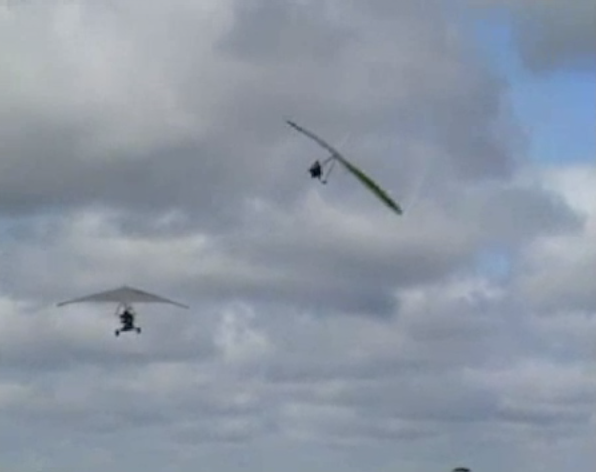
11-1814
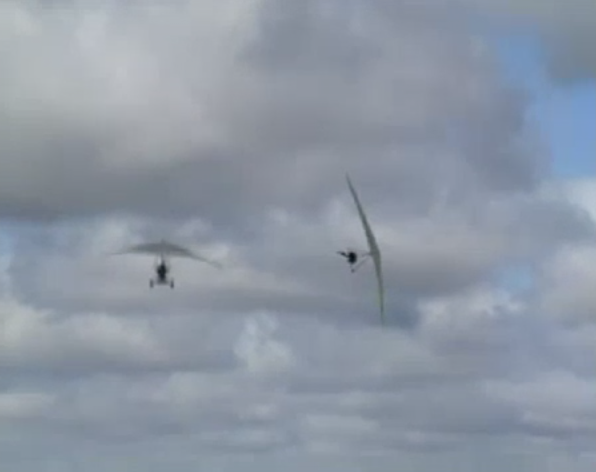
12-1915
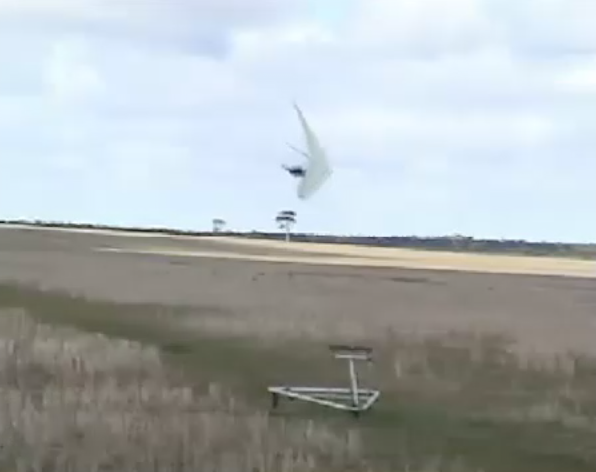
05-01816
http://farm6.staticflickr.com/5615/15166720953_a525e0e29f_o.png
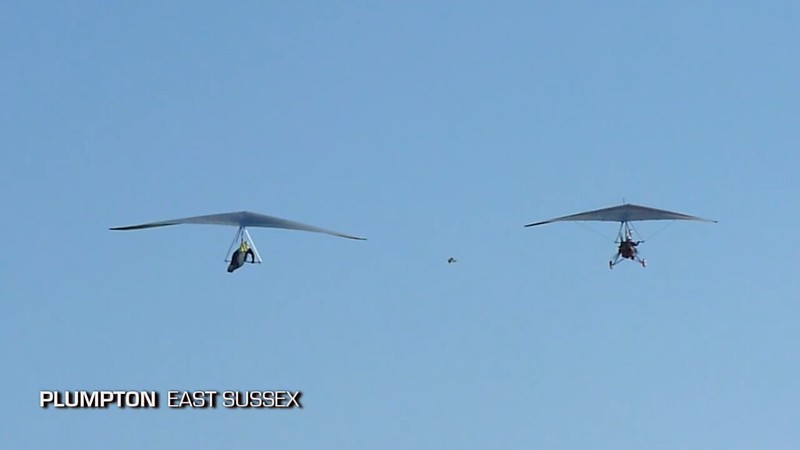
 http://farm9.staticflickr.com/8256/15786161205_1b6de38d88_o.png
http://farm9.staticflickr.com/8256/15786161205_1b6de38d88_o.png
15-03805
32-05112
http://farm9.staticflickr.com/8678/16647791555_fc1dd7a795_o.png

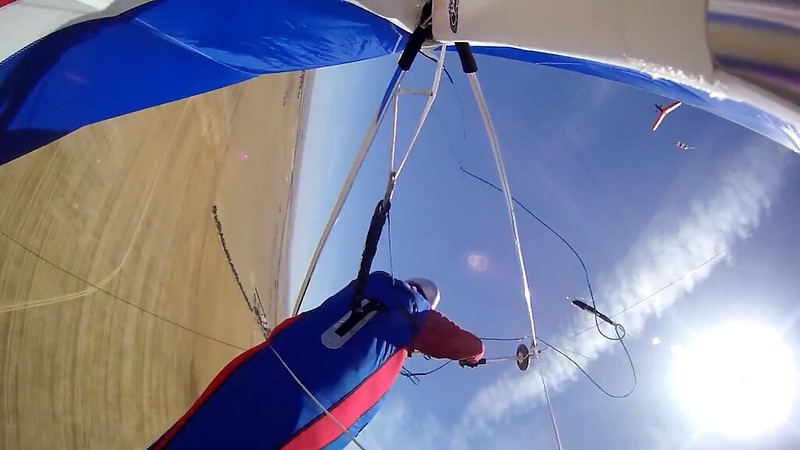 http://farm8.staticflickr.com/7309/11414153476_3ca8cc4036_o.png
http://farm8.staticflickr.com/7309/11414153476_3ca8cc4036_o.png
42-05328
Those are all gliders getting actually, seriously, and, for the purpose of the exercise, fatally locked out. And the trikes aren't the slightest bit FAZED.
---
2020/09/12 10:45:00 UTC - Edited.
